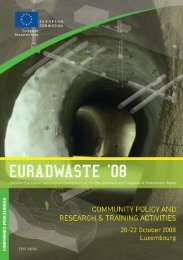EU industrial structure - EU Bookshop - Europa
EU industrial structure - EU Bookshop - Europa
EU industrial structure - EU Bookshop - Europa
You also want an ePaper? Increase the reach of your titles
YUMPU automatically turns print PDFs into web optimized ePapers that Google loves.
FIgURE IV.3: <strong>EU</strong>-27 RCA index in 2009<br />
Printing<br />
Beverages<br />
Tobacco<br />
Pharmaceuticals<br />
Paper<br />
Motor vehicles<br />
Furniture<br />
Machinery n.e.c.<br />
Rubber & plastics<br />
Non-metallic mineral products<br />
Wood & wood products<br />
Chemicals<br />
Metal products<br />
Other transport eq.<br />
Food<br />
Electrical equipment<br />
Leather & footwear<br />
Basic metals<br />
Rened petroleum<br />
Clothing<br />
Other manufacturing<br />
Textiles<br />
Computers, electronic & optical<br />
Chapter IV — International competitiveness of <strong>EU</strong> industry<br />
0.0 0.2 0.4 0.6 0.8 1.0 1.2 1.4 1.6 1.8 2.0<br />
Source: own calculations using COMTRADE data.<br />
Cyprus, Greece, Lithuania, Luxembourg, the Netherlands,<br />
Portugal and Romania, all appeared to be highly specialised in<br />
tobacco products in 2009. Wood and wood products is another<br />
category of goods where many <strong>EU</strong> countries recurrently exhibit<br />
high revealed comparative advantages. The high RCAs in<br />
wood and wood products of Austria, Estonia, Finland, Latvia<br />
and Portugal are in line with the specialisation patterns that<br />
could be observed in Section II.1 (Table II.2). Interestingly, only<br />
Finland and Sweden are the only countries which are highly<br />
specialised in paper and paper products. Cyprus and Ireland,<br />
followed by Belgium appear to be significant players in basic<br />
pharmaceutical products. In Ireland, this is also coupled with<br />
high RCAs in chemical products. Bulgaria and Romania are<br />
the only <strong>EU</strong> remnants that still had high revealed comparative<br />
advantages in trade of wearing apparel while Portugal,<br />
Italy and Romania have important revealed comparative<br />
advantages in leather and related products.<br />
In reference to Section II.1.2, and as illustrated in Figure II.6,<br />
smaller countries tend to have stronger specialisation<br />
patterns. This also applies to sectoral trade characteristics.<br />
A problem with the RCA measure is that countries with<br />
a relatively small manufacturing industry can turn out to<br />
have high RCAs even though the industry with the high<br />
RCA only consists of a few firms but accounts for a large<br />
share of total manufacturing exports in the country. Natural<br />
examples in the <strong>EU</strong> are Cyprus, Luxemburg and Malta where<br />
some industries display very high RCAs.<br />
Compared to the <strong>EU</strong>, the US seemed to have high<br />
revealed comparative advantages in the following groups<br />
of products in 2009: other manufacturing, computer,<br />
electronic and optical products, chemicals, refined<br />
petroleum products and machinery, and equipment.<br />
Japan had high RCAs in capital equipment, particularly<br />
motor vehicles and machinery. In China, the trade<br />
specialisation profile is strongly oriented towards textiles,<br />
clothing, leather and furniture; although China also<br />
has a high RCA in sectors such as office machinery and<br />
computers, cf. Table IV.8.<br />
107
















